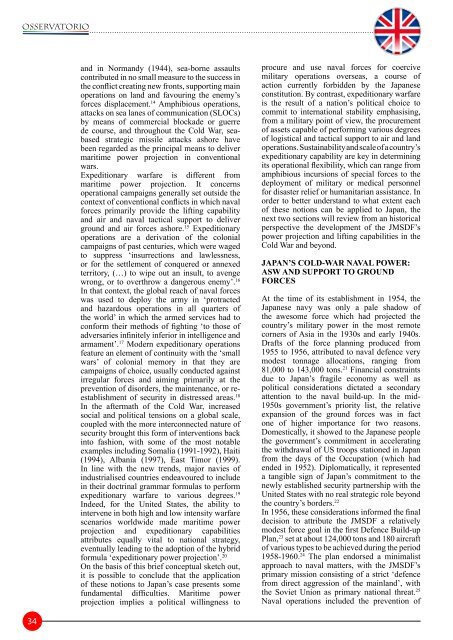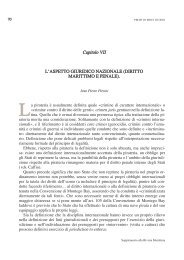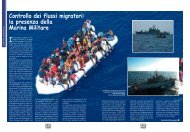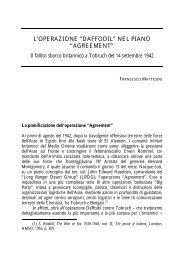143 Anno XVIII - 2008 - Marina Militare
143 Anno XVIII - 2008 - Marina Militare
143 Anno XVIII - 2008 - Marina Militare
You also want an ePaper? Increase the reach of your titles
YUMPU automatically turns print PDFs into web optimized ePapers that Google loves.
3<br />
and in Normandy (1944), sea-borne assaults<br />
contributed in no small measure to the success in<br />
the conflict creating new fronts, supporting main<br />
operations on land and favouring the enemy’s<br />
forces displacement. 14 Amphibious operations,<br />
attacks on sea lanes of communication (SLOCs)<br />
by means of commercial blockade or guerre<br />
de course, and throughout the Cold War, seabased<br />
strategic missile attacks ashore have<br />
been regarded as the principal means to deliver<br />
maritime power projection in conventional<br />
wars.<br />
Expeditionary warfare is different from<br />
maritime power projection. It concerns<br />
operational campaigns generally set outside the<br />
context of conventional conflicts in which naval<br />
forces primarily provide the lifting capability<br />
and air and naval tactical support to deliver<br />
ground and air forces ashore. 15 Expeditionary<br />
operations are a derivation of the colonial<br />
campaigns of past centuries, which were waged<br />
to suppress ‘insurrections and lawlessness,<br />
or for the settlement of conquered or annexed<br />
territory, (…) to wipe out an insult, to avenge<br />
wrong, or to overthrow a dangerous enemy’. 16<br />
In that context, the global reach of naval forces<br />
was used to deploy the army in ‘protracted<br />
and hazardous operations in all quarters of<br />
the world’ in which the armed services had to<br />
conform their methods of fighting ‘to those of<br />
adversaries infinitely inferior in intelligence and<br />
armament’. 17 Modern expeditionary operations<br />
feature an element of continuity with the ‘small<br />
wars’ of colonial memory in that they are<br />
campaigns of choice, usually conducted against<br />
irregular forces and aiming primarily at the<br />
prevention of disorders, the maintenance, or reestablishment<br />
of security in distressed areas. 18<br />
In the aftermath of the Cold War, increased<br />
social and political tensions on a global scale,<br />
coupled with the more interconnected nature of<br />
security brought this form of interventions back<br />
into fashion, with some of the most notable<br />
examples including Somalia (1991-1992), Haiti<br />
(1994), Albania (1997), East Timor (1999).<br />
In line with the new trends, major navies of<br />
industrialised countries endeavoured to include<br />
in their doctrinal grammar formulas to perform<br />
expeditionary warfare to various degrees. 19<br />
Indeed, for the United States, the ability to<br />
intervene in both high and low intensity warfare<br />
scenarios worldwide made maritime power<br />
projection and expeditionary capabilities<br />
attributes equally vital to national strategy,<br />
eventually leading to the adoption of the hybrid<br />
formula ‘expeditionary power projection’. 20<br />
On the basis of this brief conceptual sketch out,<br />
it is possible to conclude that the application<br />
of these notions to Japan’s case presents some<br />
fundamental difficulties. Maritime power<br />
projection implies a political willingness to<br />
procure and use naval forces for coercive<br />
military operations overseas, a course of<br />
action currently forbidden by the Japanese<br />
constitution. By contrast, expeditionary warfare<br />
is the result of a nation’s political choice to<br />
commit to international stability emphasising,<br />
from a military point of view, the procurement<br />
of assets capable of performing various degrees<br />
of logistical and tactical support to air and land<br />
operations. Sustainability and scale of a country’s<br />
expeditionary capability are key in determining<br />
its operational flexibility, which can range from<br />
amphibious incursions of special forces to the<br />
deployment of military or medical personnel<br />
for disaster relief or humanitarian assistance. In<br />
order to better understand to what extent each<br />
of these notions can be applied to Japan, the<br />
next two sections will review from an historical<br />
perspective the development of the JMSDF’s<br />
power projection and lifting capabilities in the<br />
Cold War and beyond.<br />
jaPan’s cold-war naval Power:<br />
asw and suPPort to ground<br />
forces<br />
At the time of its establishment in 1954, the<br />
Japanese navy was only a pale shadow of<br />
the awesome force which had projected the<br />
country’s military power in the most remote<br />
corners of Asia in the 1930s and early 1940s.<br />
Drafts of the force planning produced from<br />
1955 to 1956, attributed to naval defence very<br />
modest tonnage allocations, ranging from<br />
81,000 to <strong>143</strong>,000 tons. 21 Financial constraints<br />
due to Japan’s fragile economy as well as<br />
political considerations dictated a secondary<br />
attention to the naval build-up. In the mid-<br />
1950s government’s priority list, the relative<br />
expansion of the ground forces was in fact<br />
one of higher importance for two reasons.<br />
Domestically, it showed to the Japanese people<br />
the government’s commitment in accelerating<br />
the withdrawal of US troops stationed in Japan<br />
from the days of the Occupation (which had<br />
ended in 1952). Diplomatically, it represented<br />
a tangible sign of Japan’s commitment to the<br />
newly established security partnership with the<br />
United States with no real strategic role beyond<br />
the country’s borders. 22<br />
In 1956, these considerations informed the final<br />
decision to attribute the JMSDF a relatively<br />
modest force goal in the first Defence Build-up<br />
Plan, 23 set at about 124,000 tons and 180 aircraft<br />
of various types to be achieved during the period<br />
1958-1960. 24 The plan endorsed a minimalist<br />
approach to naval matters, with the JMSDF’s<br />
primary mission consisting of a strict ‘defence<br />
from direct aggression of the mainland’, with<br />
the Soviet Union as primary national threat. 25<br />
Naval operations included the prevention of
















